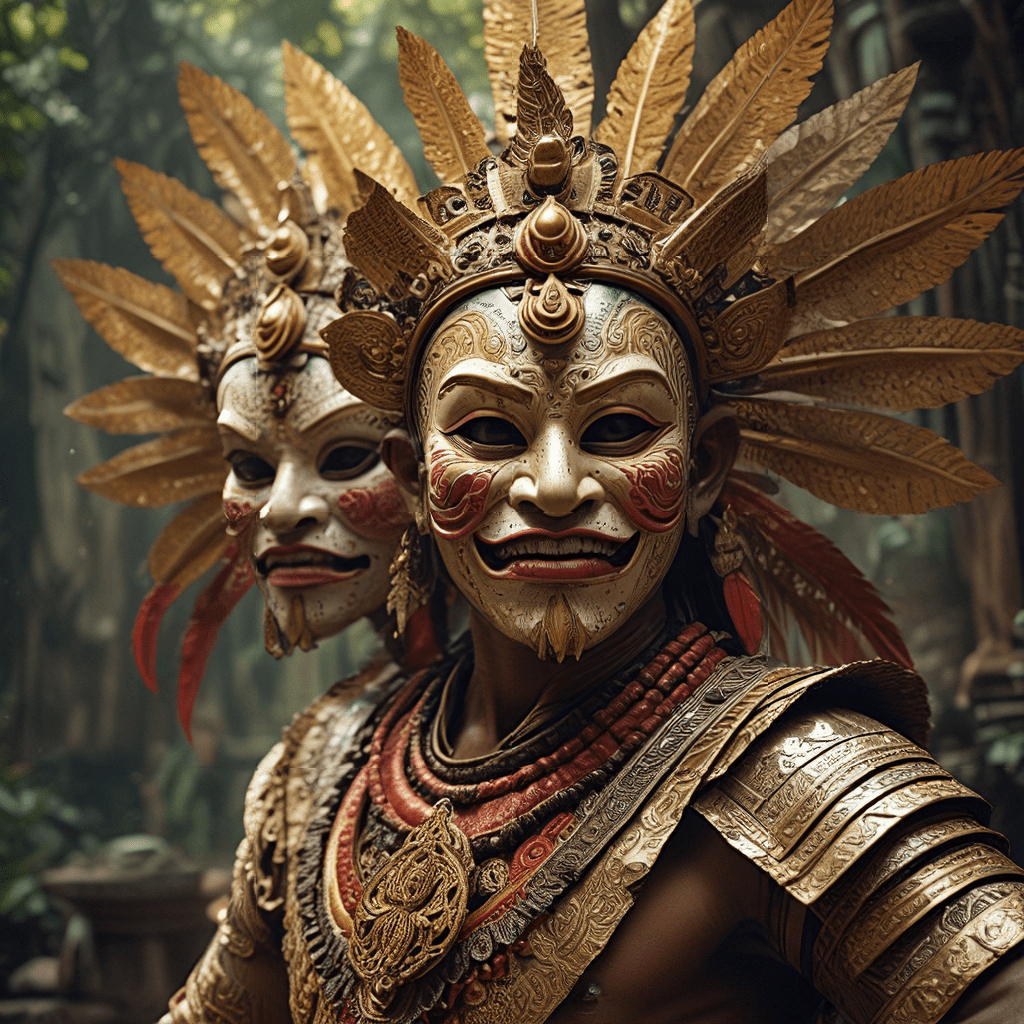Indonesian Masks: Myths and Legends Unveiled
Indonesian masks are more than just decorative objects. They are powerful symbols that hold within them the essence of Indonesian mythology, beliefs, and traditions. These masks, carved with intricate details and imbued with spiritual significance, offer a glimpse into the captivating world of Indonesian folklore.
A Tapestry of Beliefs: Exploring the Diverse Origins of Indonesian Masks
The Indonesian archipelago, with its diverse cultures and traditions, boasts a rich tapestry of mask-making traditions. Each island, each ethnic group, has its own unique legends and stories that are reflected in the masks they create. Masks serve as tangible expressions of the deep-rooted beliefs and myths that have shaped Indonesian society for centuries.
From the majestic Dayak tribes of Borneo to the Balinese artisans of the island of Bali, each community has its own distinct style and significance associated with its masks. For example, the Dayak masks, often carved from wood, represent powerful spirits and deities, while the Balinese masks, known for their elaborate ornamentation, are used in traditional dance and ceremonies.
Beyond Decoration: The Symbolic Power of Indonesian Masks
While masks are visually stunning, their true power lies in their symbolic meaning. Each mask is meticulously crafted to represent specific deities, spirits, or characters from Indonesian mythology.
The masks are not merely representations; they are considered to be vessels that embody the essence of the beings they represent. They act as a conduit between the human world and the spiritual realm, connecting individuals to the power and wisdom of the deities they embody.
Masks as Portals: Communicating with the Divine and the Ancestral
In many Indonesian traditions, masks are used as a means of communication with the divine and the ancestral spirits. By wearing a mask, a performer is able to embody the spirit of the deity or ancestor they are representing, allowing them to interact with the supernatural world. This communication often takes place during rituals, ceremonies, and performances.
The Faces of Myth: Representing Gods, Spirits, and Supernatural Beings
Indonesian masks are a fascinating window into the rich and diverse mythology of the region. Each mask tells a story, often depicting a specific god, spirit, or supernatural being. For example, the mythical creature known as the "Barong" – a lion-like figure with a human face – is often depicted in Balinese masks and represents the principle of good and righteousness.
These masks don't just visually represent these beings; they encapsulate their essence, their power, and their role in the Indonesian mythological tapestry. They allow viewers to connect with these figures on a deeper, spiritual level.
Ritual and Ceremony: The Role of Masks in Traditional Performances
Indonesian masks play a vital role in traditional performances, often serving as a bridge between the spiritual and the earthly realms. These rituals and ceremonies, passed down through generations, are an integral part of Indonesian cultural life.
In Balinese dance, for example, masks are essential for portraying deities, mythical creatures, and characters from Hindu epics like the Ramayana. The masks, combined with elaborate costumes and intricate movements, transform the performers into divine beings, bringing the stories to life. These performances are not just entertainment; they are acts of devotion, a way to honor the gods and ancestors.
Masks are also used in ceremonies related to life cycle events, such as weddings, births, and funerals. In these ceremonies, masks may represent protective spirits, ancestral figures, or deities who are believed to bless and guide individuals through these significant life transitions.
From Myth to Man: The Transformative Power of the Mask
The act of wearing a mask is a powerful ritual that transforms the wearer, connecting them to the spirit or deity embodied in the mask. This transformation is not just physical; it is also spiritual and psychological. The wearer becomes a conduit for the energy and power of the mask, allowing them to act as a representative of the divine.
This transformative power of masks is evident in traditional dances and rituals. The performers become more than just individuals; they embody the mythical characters they portray, bringing the stories and legends to life. The masks become a vehicle for connecting with the divine and understanding the complex relationship between humans and the spiritual realm.
The Mask as a Mirror: Reflecting Cultural Values and Beliefs
Indonesian masks are not only expressions of mythology, but also reflections of the cultural values and beliefs of the people who create them. The intricate details, the choice of materials, and the symbolic meanings embedded in the masks all speak to the values and beliefs of the community.
For example, the elaborate ornamentation found in Balinese masks reflects the importance of beauty and aesthetics in Balinese culture. Similarly, the masks of the Dayak tribes, often featuring fierce and powerful expressions, reflect the importance of strength and courage in their society.
By studying the masks, we can gain insights into the worldview, social structure, and beliefs of the communities that created them. Masks become a window into the heart and soul of Indonesian culture.
The Evolution of Indonesian Masks: Adaptation and Innovation
Over time, Indonesian mask-making traditions have evolved, adapting to changing cultural contexts and incorporating new influences. While the core principles and meanings of the masks have remained largely intact, the styles and techniques have been adapted to reflect the changing times.
New materials and techniques have been introduced, and the designs have evolved to reflect contemporary influences. For example, some modern masks incorporate elements of contemporary art and design, while others use traditional materials and techniques but with a more modern aesthetic.
A Legacy of Creativity: The Enduring Influence of Mask-Making Traditions
Mask-making traditions continue to thrive in Indonesia, passed down from generation to generation, ensuring the preservation of cultural heritage. The skills and knowledge of mask-making are passed down through apprenticeship, ensuring that the tradition remains alive and vibrant.
The enduring influence of these traditions is evident in the continued use of masks in contemporary art, fashion, and design. The symbolic meanings and aesthetic appeal of Indonesian masks continue to inspire artists and designers, ensuring that the legacy of mask-making lives on.
The Modern Context: Masks as Symbols of Cultural Identity and Heritage
In the modern world, Indonesian masks are increasingly recognized as valuable symbols of cultural identity and heritage. They serve as a reminder of the rich and diverse history of the archipelago, bringing together people from different backgrounds and communities.
Masks are also used in contemporary art and performance as a way of exploring and reinterpretiting traditional themes and stories. Artists and performers use masks to engage with the legacy of their ancestors, to express their own cultural identity, and to share their stories with the world.
FAQ
Q: What are Indonesian masks made of?
A: Indonesian masks are typically made from wood, but can also be made from materials like leather, fiber, and even textiles.
Q: What are some of the most famous Indonesian masks?
A: Some of the most famous Indonesian masks include the Barong (Balinese), the Topeng (Javanese), and the Dayak masks (Borneo).
Q: What are some of the meanings behind Indonesian masks?
A: The specific meanings of Indonesian masks vary depending on the culture and community that created them. However, they often represent deities, spirits, ancestors, and other supernatural beings.



